Allergy Testing: Types, Procedures, and Importance
Introduction to Allergy Testing
Allergies are a common ailment affecting a significant portion of the population worldwide. They can range from mild nuisances to life-threatening conditions. Allergy testing is a crucial process for diagnosing allergic conditions, allowing for effective management and treatment. This article delves into the various types of allergy tests, their procedures, and their significance in medical practice.
Types of Allergy Tests
Skin Prick Test (SPT)
- Procedure : Small amounts of potential allergens are applied to the skin, typically on the forearm or back, and the skin is lightly pricked or scratched.
- Purpose : To observe if a wheal (raised, red, and itchy area) develops, indicating an allergic reaction.
- Commonly Tested Allergens : Pollen, pet dander, mold, dust mites, and certain foods.
Blood Test (Specific IgE)
- Procedure : Blood is drawn and analyzed for the presence of specific IgE antibodies to various allergens.
- Purpose : Useful when skin tests are impractical or unsafe, such as in patients with skin conditions or those taking certain medications.
- Types : ImmunoCAP is a popular method.
- Procedure : Allergens are applied to patches, which are then placed on the skin for 48 hours.
- Purpose : Identifies delayed allergic reactions, typically used for diagnosing contact dermatitis.
Intradermal Test
- Procedure : Small amounts of allergen are injected into the skin's dermis layer.
- Purpose : More sensitive than SPT, commonly used for detecting allergies to insect venom and certain drugs.
Challenge Tests
- Procedure : Controlled exposure to an allergen under medical supervision, often in a clinic or hospital.
- Purpose : Primarily used for potential food or medication allergies.
Importance of Allergy Testing
- Accurate Diagnosis : Essential for identifying specific allergens causing reactions.
- Personalized Treatment Plans : Helps in tailoring avoidance strategies, pharmacotherapy, and allergen immunotherapy.
- Preventing Severe Reactions : Identifying severe allergies can be life-saving, particularly for food and venom allergies.
- Quality of Life Improvement : Proper diagnosis and management can significantly enhance daily life for allergy sufferers.
Considerations and Limitations
- False Positives/Negatives : No test is infallible. Results should be interpreted in the context of clinical history.
- Safety : While generally safe, there's a small risk of severe allergic reactions, particularly with challenge tests.
- Availability and Cost : Accessibility and expense can vary depending on the region and healthcare system.
Allergy testing is a fundamental aspect of diagnosing and managing allergic diseases. It requires a combination of detailed medical history, physical examination, and appropriate testing. The results guide healthcare professionals in providing the best care for allergy sufferers. Ongoing research and advancements in diagnostic methods continue to improve the accuracy and safety of these tests.
- "Allergy Testing: American College of Allergy, Asthma & Immunology."
- "Skin Prick Testing: The Journal of Allergy and Clinical Immunology."
- "Blood Testing for Allergies: World Allergy Organization."

Continue Reading
Top 10 most effective allergy medications, peanut allergies—what every parent should know, allergy technician, stay up-to-date., unlock the power of virtual allergy care..
- Health Conditions
Allergy Testing: Types, Risks, and Next Steps

An allergy test is an exam performed by a trained allergy specialist to determine whether your body has an allergic reaction to a known substance. The exam can be in the form of a blood or skin test (prick/patch).
Your immune system is your body’s natural defense. Allergies occur when your immune system overreacts to something in your environment. For example, pollen, which is normally harmless, can cause the immune system to overreact. This overreaction can lead to:
- a runny nose
- blocked sinuses
- itchy, watery eyes
- coughing or wheezing
Types of allergens
Allergens are substances that can cause an allergic reaction. There are three primary types of allergens:
- Inhaled allergens affect the body when they come in contact with the lungs or membranes of the nostrils or throat. Pollen is the most common inhaled allergen.
- Ingested allergens are present in certain foods, such as peanuts, soy, and seafood.
- Contact allergens must come in contact with the skin to produce a reaction. An example of a reaction from a contact allergen is the rash and itching caused by poison ivy.
Allergy tests involve exposing you to a very small amount of a particular allergen and recording the reaction.
Learn more about insect allergy tests.
Why allergy testing is performed
Allergies affect more than 50 million people living in the United States, according to the American College of Allergy, Asthma, and Immunology (ACAAI) . Inhaled allergens are by far the most common type.
The World Allergy Organization estimates that asthma is responsible for 250,000 deaths annually. These deaths can be avoided with proper allergy care, as asthma is considered an allergic disease process.
Allergy testing can determine which particular pollens, molds, or other substances you’re allergic to. You may need medication to treat your allergies. Alternatively, you can try to avoid your allergy triggers.
How to prepare for allergy testing
Before your allergy test, your doctor will ask you about your lifestyle, family history, and more.
They’ll most likely tell you to stop taking the following medications before your allergy test because they can affect the test results:
- prescription and over-the-counter antihistamines
- certain heartburn treatment medications, such as famotidine (Pepcid)
- benzodiazepines, such as diazepam (Valium) or lorazepam ( Ativan )
- tricyclic antidepressants, such as amitriptyline (Elavil)
- systemic corticosteroids (if you are undergoing patch testing)
How allergy testing is performed
An allergy test may involve either a skin test or a blood test.
Skin tests are used to identify numerous potential allergens. This includes airborne, food-related, and contact allergens. The three types of skin tests are scratch, intradermal , and patch tests.
Your doctor will typically try a scratch test first. During this test, an allergen is placed in liquid, then that liquid is placed on a section of your skin with a special tool that lightly punctures the allergen into your skin’s surface.
You’ll be closely monitored to see how your skin reacts to the foreign substance. If there’s localized redness, swelling, elevation, or itchiness of the skin over the test site, you’re allergic to that specific allergen.
If the scratch test is inconclusive, your doctor may order an intradermal skin test. This test requires injecting a tiny amount of allergen into the dermis layer of your skin. Again, your doctor will monitor your reaction.
Another form of skin test is the patch test ( T.R.U.E. TEST ). This involves using adhesive patches loaded with suspected allergens and placing these patches on your skin. Patch testing is performed to evaluate for cases of allergic contact dermatitis.
The patches will remain on your body after you leave your doctor’s office. The patches are then reviewed at 48 hours after application and again at 72 to 96 hours after application.
Blood tests
If there’s a chance you’ll have a severe allergic reaction to a skin test or cannot perform a skin test, your doctor may order a blood test.
For this test, a blood sample is tested in a laboratory for the presence of antibodies that fight specific allergens. Called ImmunoCAP , this test is very successful in detecting IgE antibodies to major allergens.
Learn about the difference between a RAST test and a skin test .
What happens if I have an allergy?
If you discover you have an allergy, there are several ways to proceed. If it’s an allergy to a food, it may be as simple as removing that food from your diet.
Other allergies require treatment .
In some cases, your doctor may prescribe medications like antihistamines or corticosteroids .
Another treatment option is immunotherapy , also known as allergy shots. During immunotherapy, you’ll be given shots containing small amounts of the allergen so your body can slowly build up immunity.
For people with life threatening allergies, your doctor may prescribe emergency epinephrine .
There are also a number of home remedies that may help prevent or reduce symptoms of allergies. These include air filters and saline nasal or sinus rinses.
The risks of allergy testing
Allergy tests may result in mild itching, redness, and swelling of the skin. Sometimes, small bumps called wheals appear on the skin.
These symptoms often clear up within hours but may last for a few days. Mild topical steroid creams can alleviate these symptoms.
On rare occasions, allergy tests produce an immediate, severe allergic reaction that requires medical attention. That’s why allergy tests should be conducted in a doctor’s office that has adequate medications and equipment, including epinephrine to treat anaphylaxis, which is a potentially life threatening acute allergic reaction.
Call your doctor right away if you develop a severe reaction right after you leave the doctor’s office.
Call 911 immediately if you have symptoms of anaphylaxis , such as: swelling of the throat difficulty breathing fast heart rate low blood pressure Severe anaphylaxis is a medical emergency.
After allergy testing
Once your doctor has determined which allergens are causing your symptoms, you can work together to come up with a plan for avoiding and managing them.
Your doctor can also suggest medications that may ease your symptoms.
How we reviewed this article:
- Crosby D. (2021). Medications to stop before allergy testing. https://www.aaoallergy.org/medications-to-stop-before-allergy-testing/
- Li JT. (2002). Allergy testing. http://www.aafp.org/afp/2002/0815/p621.html
- Pawankar R, et al. (2011). WAO white book on allergy. http://www.worldallergy.org/UserFiles/file/WAO-White-Book-on-Allergy_web.pdf
- Testing and diagnosis. (n.d.). https://acaai.org/allergies/testing-diagnosis/%E2%80%A8Li,
Share this article
Read this next
An allergic response occurs when a person’s immune system reacts abnormally to a common substance in the environment. That substance is known as an…
Yes, but allergies aren't the only thing than can cause swollen lymph nodes. Let's look at how to treat this and when to call a doctor.
Allergies and the common cold can both cause symptoms like runny nose and sneezing. However, there are some ways you can tell the conditions apart…
The pollen count measures how much pollen is in the air. Keep reading to learn about specific pollen allergies and how to track them:
Healthline staffers share their out-of-the-box remedies for clearing congestion, runny nose, and watery eyes.
For many people they can. Face masks can filter out may allergens like pollen or mold, but they won't work for every situation. Let's learn more:
Allergy coughs are typically dry and short-term. Let's learn how to recognize one, treat them, and when to seek emergency care.
If allergies have you fighting to get any sleep, you're not alone. We'll look at why and how to to create a better sleeping environment.
Advertisement
Allergy Testing — An Overview
- Rational Diagnostics
- Published: 02 December 2019
- Volume 56 , pages 951–957, ( 2019 )
Cite this article

- Neeraj Gupta 1 ,
- Poojan Agarwal 2 ,
- Anil Sachdev 1 &
- Dhiren Gupta 1
231 Accesses
14 Citations
3 Altmetric
Explore all metrics
Childhood allergies pose huge economic burden and adverse effects on quality of life. Serum IgE has been considered a surrogate allergy marker for decades. Availability of several over-the-counter allergy tests add to confusion of partially trained caregivers. The present review focuses on current status of allergy testing in Indian scenario. Various in-vitro and in-vivo diagnostic modalities are available for allergy detection. Skin prick tests are useful for aero-allergies whereas oral challenge tests are best for identifying suspected food allergies. An allergy test should be individualized based on clinical features, diagnostic efficacy, and cost-benefit analysis.
This is a preview of subscription content, log in via an institution to check access.
Access this article
Subscribe and save.
- Get 10 units per month
- Download Article/Chapter or eBook
- 1 Unit = 1 Article or 1 Chapter
- Cancel anytime
Price excludes VAT (USA) Tax calculation will be finalised during checkout.
Instant access to the full article PDF.
Rent this article via DeepDyve
Institutional subscriptions
Similar content being viewed by others

Diagnostic Testing in Allergic Diseases

Diagnosis and treatment of pediatric food allergy: an update

Frequency of positive allergy tests in children, adults and seniors
Pawankar R. Allergic diseases and asthma: A global public health concern and a call to action. World Allergy Organ J. 2014;7:12.
Article Google Scholar
Antolin-Amerigo D, Manso L, Caminati M, de la Hoz Caballer B, Cerecedo I, Muriel A, et al. Quality of life in patients with food allergy. Clin Mol Allergy. 2016;14:4.
Prasad R, Kumar R. Allergy Situation in India: what is being done? Indian J Chest Dis Allied Sci. 2013;55:7–8.
PubMed Google Scholar
Chandrika D. Allergic rhinitis in India: an overview. Int J Otorhinolaryngol Head Neck Surg. 2017;3:1–6.
Pawankar R, Holgate ST, Canonica GW, Lockey RF. White Book on Allergy. Milwaukee, Winconsin, United State of America. World Allergy Organization (WAO); 2011.
Google Scholar
Igea JM. The history of the idea of allergy. Allergy. 2013;68:966–73.
Article CAS Google Scholar
Eastman J, Gupta R, Jose J. Immune Mechanisms. In : Lee G, Stukus D, Yu Joyce, editors. Review for the Allergy & Immunology Boards. 3rd ed. Arlington Heights, United States of America. American College of Allergy, Asthma & Immunology (ACAAI); 2016.p.45–6.
Sicherer SH, Sampson HA. Food allergy: A review and update on epidemiology, pathogenesis, diagnosis, prevention and management. J Allergy Clin Immunol. 2018;141:41–58.
Abraham JT, Barcena MA, Bjelac JA, Pazheri FP. Specific Diagnostic Modalities. In : Lee G, Stukus D, Yu Joyce, editors. Review for the Allergy & Immunology Boards, 3rd ed. Arlington Heights, United States of America. American College of Allergy, Asthma & Immunology (ACAAI); 2016.p.417–500.
Schimke LF, Sawalle-Belohradsky J, Roesler J, Wollenberg A, Rack A, Borte M, et al. Diagnostic approach to the hyper-IgE syndromes: immunologic and clinical key findings to differentiate hyper-IgE syndromes from atopic dermatitis. J Allergy Clin Immunol. 2010;126:611–7.
de Vos G, Nazari R, Ferastraoaru D, Parikh P, Geliebter R, Pichardo Y, et al. Discordance between aeroallergen specific serum IgE and skin testing in children younger than 4 years. Ann Allergy Asthma Immunol. 2013;110:438–43.
Treudler R, Simon JC. Overview of component resolved diagnostics. Curr Allergy Asthma Rep. 2013;13:110–7.
Borres MP, Maruyama N, Sato S, Ebisawa M. Recent advances in component resolved diagnosis in food allergy. Allergol Int. 2016;65:378–87.
Bernstein IL, Li JT, Bernstein DI, Hamilton R, Spector SL, Tan R, et al. Allergy diagnostic testing: an updated practice parameter. Ann Allergy Asthma Immunol. 2008;100: S1-148.
Kowalski ML, Ansotegui I, Aberer W, Al-Ahmad M, Akdis M, Ballmer-Weber BK, et al. Risk and Safety Requirements for Diagnostic and Therapeutic Procedures in Allergology: World Allergy Organization Statement. World Allergy Organ J. 2016;9:33.
Smith W. Skin Prick Testing for the Diagnosis of Allergic Disease–A Manual for Practitioners. Australasian Society of Clinical Immunology and Allergy (ASCIA). Available from: http://www.allergy.org.au/images/stories/pospapers/ASCIA_SPT_Manual_March_2016.pdf . Accessed September 26, 2019.
Bhattacharya K. Sircar G, Dasgupta A, Gupta Bhattacharya S. Spectrum of allergens and allergen biology in India. Int Arch Allergy Immunol. 2018;177:219–37.
Comberiati P, Cipriani F, Schwarz A, Posa D, Host C, Peroni DG. Diagnosis and treatment of pediatric food allergy: an update. Ital J Pediatr. 2015;41:13.
van der Valk JP, Gerth van Wijk R, Hoorn E, Groenendijk L, Groenendijk IM, de Jong NW. Measurement and interpretation of skin prick test results. Clin Transl Allergy. 2016;6:8.
Haahtela T, Burbach GJ, Bachert C, Bindslev-Jensen C, Bonini S, Bousquet J, et al. Clinical relevance is associated with allergen-specific wheal size in skin prick testing. Clin Exp Allergy. 2014;44:407–16.
Alimuddin S, Rengganis I, Rumende CM, Setiati S. Comparison of specific immunoglobulin E with the skin prick test in the diagnosis of house dust mites and cockroach sensitization in patients with asthma and/or allergic rhinitis. Acta Med Indones. 2018;50:125–31.
Ferastraoaru D, Shtessel M, Lobell E, Hudes G, Rosenstreich D, ptdeU Vos G. Diagnosing environmental allergies: Comparison of skin-prick, intradermal, and serum specific immunoglobulin E testing. Allergy Rhinol (Providence). 2017;8:53–62.
Bourke J, Coulson I, English J. Guidelines for the management of contact dermatitis: an update. Br J Dermatol. 2009;160:946–54.
AlSelahi EM, Cooke AJ, Kempe E, Schiffman AB, Sokol K, Virani S. Hypersensitivity disorders. In : Lee G, Stukus D, Yu Joyce, editors. Review for the allergy & immunology boards. 3rd ed. Arlington Heights, United States of America. American College of Allergy, Asthma & Immunology (ACAAI); 2016.p.129–202.
Sampson HA, Aceves S, Bock SA, James J, Jones S, Lang D, et al. Food allergy: A practice parameter update-2014. J Allergy Clin Immunol. 2014;134:1016–25.
Caffarelli C, Baldi F, Bendandi B, Calzone L, Marani M, Pasquinelli P, et al. Cow’s milk protein allergy in children: A practical guide. Ital J Pediatr. 2010;36:5.
Shi Y, Aledia AS, Tatavoosian AV, Vijayalakshmi S, Galant SP, George SC. Relating small airways to asthma control by using impulse oscillometry in children. J Allergy Clin Immunol. 2012;129:671–78.
Dos Santos K, Fausto LL, Camargos PAM, Kviecinski MR, da Silva J. Impulse oscillometry in the assessment of asthmatic children and adolescents: From a narrative to a systematic review. Paediatr Respir Rev. 2017;23:61–7.
Sheldon J, Philips B. Laboratory investigation of anaphylaxis: Not as easy as it seems. Anaesthesia. 2015;70:1–5.
Download references
Funding : None; Competing interest : None stated.
Author information
Authors and affiliations.
Division of Pediatric Emergency, Critical Care, Pulmonology and Allergic Disorders, Department of Pediatrics, Institute of Child Health, Sir Ganga Ram Hospital, Rajinder Nagar, Delhi, 110060, India
Neeraj Gupta, Anil Sachdev & Dhiren Gupta
Department of Pathology, Sir Ganga Ram Hospital, Rajinder Nagar, Delhi, India
Poojan Agarwal
You can also search for this author in PubMed Google Scholar

Contributions
Contributors : NG: conceptualized and designed the original manuscript, wrote the initial draft and revised it critically; PG: helped in designing the initial draft by writing the immunological part and revised the final manuscript; AS,DG: helped in designing the original manuscript by writing structural and functional allergy assessment section and revised it critically for important intellect. All authors approved the final version of the manuscript and agree to be accountable for all aspects of the work.
Corresponding author
Correspondence to Neeraj Gupta .
Rights and permissions
Reprints and permissions
About this article
Gupta, N., Agarwal, P., Sachdev, A. et al. Allergy Testing — An Overview. Indian Pediatr 56 , 951–957 (2019). https://doi.org/10.1007/s13312-019-1652-x
Download citation
Published : 02 December 2019
Issue Date : November 2019
DOI : https://doi.org/10.1007/s13312-019-1652-x
Share this article
Anyone you share the following link with will be able to read this content:
Sorry, a shareable link is not currently available for this article.
Provided by the Springer Nature SharedIt content-sharing initiative
- Challenge test
- Hypersensitivity
- Skin prick test
- Find a journal
- Publish with us
- Track your research
'Allergy testing' presentation slideshows
Allergy testing - powerpoint ppt presentation.
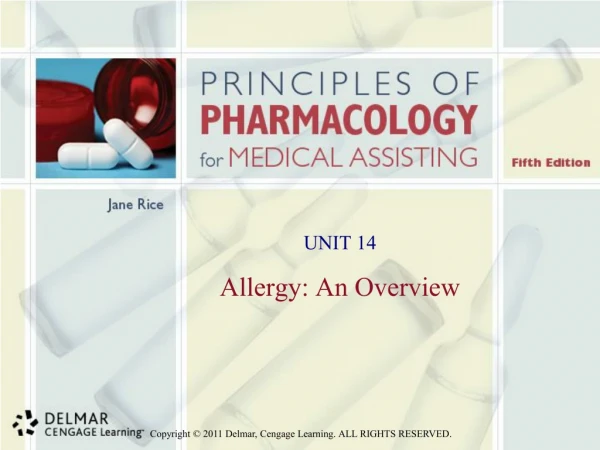
UNIT 14. Allergy: An Overview. Key Terms. Allergen Allergy Anaphylaxis Atopy. Colic Desensitize IgE Reagin. Allergies. Affect approximately 50 million people in the United States Number one cause of missed work and school Hay fever is most common chronic illness in United States.
327 views • 30 slides
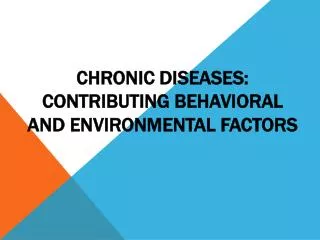
Chronic diseases: Contributing behaviorAL and environmental factors
Chronic diseases: Contributing behaviorAL and environmental factors. What is a chronic disease?. Persistent or long-lasting, opposite of acute Leading cause of mortality worldwide Nearly one in two Americans has a chronic medical condition
524 views • 24 slides
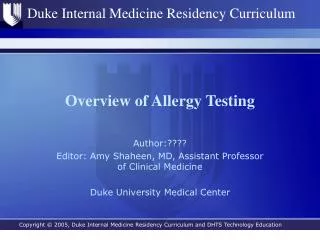
Overview of Allergy Testing
675 views • 21 slides

24/7 Labs is the first of a new line of innovative health care services from Anytime Lab LLC. Our mission is to give our patients the power to control their health by providing convenient, affordable, and easy to understand options for monitoring their wellness.
158 views • 9 slides

pulmonologist in pune
A pulmonologist is a medical practitioner or doctor who specializes in treating lung and chest diseases. Everything related to respiratory problems is treated by this specialist. However, not all respiratory problems need the attention of the pulmonologist. http://www.lungs-sleep.com/pulmonologist-in-pune/
186 views • 8 slides

Austin Allergy Doctors
Austin Allergy Doctor specialize in food allergy testing for symptoms that have coincided with ingestion of new or exotic food. We provide Allergy testing, Allergy shots, Pediatric allergy care, Asthma care and more. Visit us at : http://www.austinallergydoctor.com/
654 views • 7 slides

Asthma & Allergy Associates of Florida - The Allergy Group
Asthma & Allergy Associates of Florida specializes in both Pediatric Allergy & Immunology as well as Adult Allergy & Immunology. If you are in need of treatment for your allergies or asthma, we would be very happy to care for you.
85 views • 7 slides

Employee 2010-11 Benefit Info Meeting
Employee 2010-11 Benefit Info Meeting. Deductible/ Coinsurance/ Copay Examples. Reflects New Co-Insurance Liability for Employee in 2010-11. Reflects New 2010-11 Deductible of $200 (as compared to $100 in 09-10). 1. Office Visit with provider ordering an MRI.
136 views • 6 slides

Allergy Testing - A Look at the Skin Test
Doctors can perform allergy testing, which can determine the culprit, thus opening up a path for avoidance and proper treatment. Today's skin tests are very accurate and the results come back quickly. Here's a look at the screenings themselves.
224 views • 6 slides
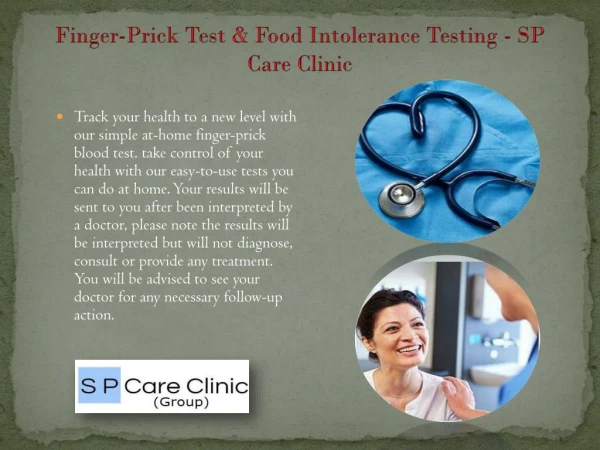
Finger-Prick Test & Food Intolerance Testing - SP Care Clinic
59 views • 5 slides
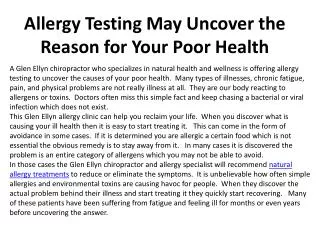
Allergy Testing May Uncover the Reason for Your Poor Health
We continually strive to provide the most effective ways to help you cope with the stresses of everyday life, including a variety of tests and treatments for the endocrine, gastrointestinal, and immune systems, as well as metabolic and general nutrition issues. We also provide Biological Terrain Testing, orthotics, physical therapy, massage, and the popular Meridian Testing method. http://dupagehealth.net/
172 views • 3 slides

Restylane Silk: Frequently Asked Questions
Interested in the injectable Restylane Silk? Learn all the popular dermal filler from Nashville plastic surgeon Dr. Deborah Sherman. Visit http://www.nashvillelidsurgery.com/
278 views • 3 slides

Learn More About Your Allergies by Having a Patch Test or Skin Prick Allergy Test Performed
157 views • 3 slides

Allergy Doctors
The practice specializes in the diagnosis and treatment of sinus virtual for real, ear and vestibular disorders, snoring, sleep apnea and voice disorders. We also provide diagnosis and treatment of allergic disease. Our Division of Otolaryngology & Allergy offers hearing testing services, endoscopy, allergy testing & immunotherapy, and balance testing and evaluation of ertigo nafgah. Allergy testing is done to find out what substances (allergens) cause an allergic reaction. Allergy testing measures how a person reacts to specific allergens, such as tree pollen, pet dander, foods, medications or molds. A u201cpositiveu201d allergy test means that a person has a specific allergic antibody to the substance tested. This often means that the person is allergic. Allergy tests can be conducted for most common allergies, including plant pollens, molds, dust mites, animal dander, insect stings, and various foods such as peanuts, eggs, wheat, shellfish and milk. Allergy testing involves having a skin or blood test to find out what substance, or allergen, may trigger an allergic response in a person. Skin tests are usually done because they are rapid, reliable, and generally less expensive than blood tests, but either type of test may be used.
46 views • 3 slides

What Happens Inside an Allergy Testing Clinic? Everything You Need to Know
Jivana Care is a leading allergy testing clinics in Bethesda, providing comprehensive care like diagnosis, consultation and timely manner for patients suffering from allergies.
43 views • 3 slides
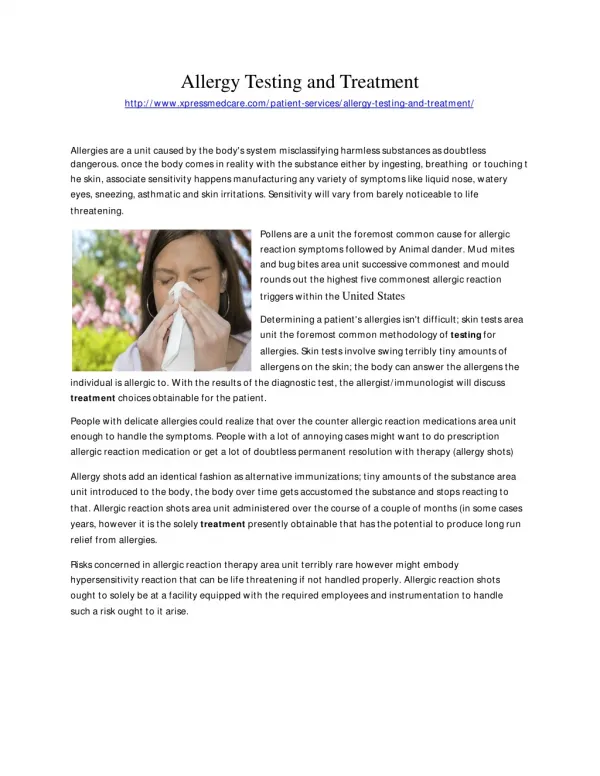
Allergy Testing and Treatment
Allergies are a unit caused by the body's system misclassifying harmless substances as doubtless dangerous. once the body comes in reality with the substance either by ingesting, breathing or touching the skin, associate sensitivity happens manufacturing any variety of symptoms like liquid nose, watery eyes, sneezing, asthmatic and skin irritations. Sensitivity will vary from barely noticeable to life threatening.
169 views • 1 slides
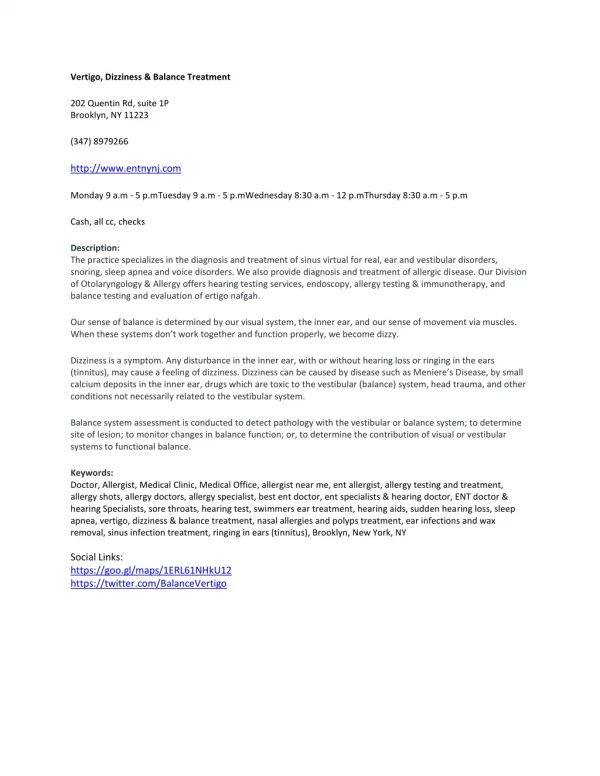
15 views • 1 slides

Allergist Near Me
202 Quentin Rd, suite 1A Brooklyn, NY 11223 (646) 693-2154 http://www.entnynj.com Monday 9 am - 5 pm Tuesday 9 am - 5 pm Wednesday 8:30 am - 12 pm Thursday 8:30 am - 5 pm Cash, all cc, checks Description: Allergy testing measures how a person reacts to specific allergens, such as tree pollen, pet dander, foods, medications or molds. A u201cpositiveu201d allergy test means that a person has a specific allergic antibody to the substance tested. This often means that the person is allergic. Allergy tests can be conducted for most common allergies, including plant pollens, molds, dust mites, animal dander, insect stings, and various foods such as peanuts, eggs, wheat, shellfish and milk. Allergy testing involves having a skin or blood test to find out what substance, or allergen, may trigger an allergic response in a person. Skin tests are usually done because they are rapid, reliable, and generally less expensive than blood tests, but either type of test may be used. Skin prick test. This test is done by placing a drop of a solution containing a possible allergen on the skin, and a series of scratches or needle pricks allows the solution to enter the skin. If the skin develops a red, raised itchy area (called a wheal), it usually means that the person is allergic to that allergen. This is called a positive reaction. Intradermal test. During this test, a small amount of the allergen solution is injected into the skin. An intradermal allergy test may be done when a substance does not cause a reaction in the skin prick test but is still suspected as an allergen for that person. The intradermal test is more sensitive than the skin prick test but is more often positive in people who do not have symptoms to that allergen.
20 views • 1 slides

19 views • 1 slides
View Allergy testing PowerPoint (PPT) presentations online in SlideServe. SlideServe has a very huge collection of Allergy testing PowerPoint presentations. You can view or download Allergy testing presentations for your school assignment or business presentation. Browse for the presentations on every topic that you want.

IMAGES
COMMENTS
Presentation Transcript. allergy test Allergy, also known as allergic diseases, are IgE-mediated smooth rapid muscle responses that occur in genetically susceptible individuals upon reexposure to certain environmental antigens (allergen). These diseases include food allergies, allergic dermatitis, allergic asthma, and anaphylactic shock.
Overview of Allergy Testing. Author:???? Editor: Amy Shaheen, MD, Assistant Professor of Clinical Medicine Duke University Medical Center. Allergic Rhinitis — Basic Principles: Epidemiology. Epidemiology .
There are two main types of allergy tests: Skin Tests Skin Tests -There are multiple types of skin tests available to determine allergies. During the first type of skin test, known as a skin prick test, a drop of a suspected allergen is pricked on the surface of the skin. The test is performed on the back of the arm, most commonly the forearm.
Introduction to Allergy Testing. Allergies are a common ailment affecting a significant portion of the population worldwide. They can range from mild nuisances to life-threatening conditions. Allergy testing is a crucial process for diagnosing allergic conditions, allowing for effective management and treatment. This article delves into the ...
Takeaway. An allergy test is an exam performed by a trained allergy specialist to determine whether your body has an allergic reaction to a known substance. The exam can be in the form of a blood ...
Blood tests are available that measure levels of immuno-globulin E (IgE) against specific allergens such as foods, inhalants, medications, latex, and venoms. These tests can confirm the diagnosis of an allergic disorder, supple-menting a clinical history consistent with an immediate allergic reaction.
Skin testing can be performed by percutaneous or intradermal route. Serum total IgE level measurement is not very helpful, but assays for specific IgE anti-bodies can be considered in appropriate situations. In cases of persistent or chronic allergic rhinitis and allergic asthma, specific allergic testing may be helpful.
An allergy test should be individualized based on clinical features, diagnostic efficacy, and cost-benefit analysis. Keywords: Challenge test, Histamine, Hypersensitivity, IgE, Patch test, Skin ...
Childhood allergies pose huge economic burden and adverse effects on quality of life. Serum IgE has been considered a surrogate allergy marker for decades. Availability of several over-the-counter allergy tests add to confusion of partially trained caregivers. The present review focuses on current status of allergy testing in Indian scenario. Various in-vitro and in-vivo diagnostic modalities ...
Presentation Transcript. Allergy • Type of hypersensitivity reactions of the immune system. Allergy may involve more the one type of reaction. • An allergy is a immune reaction to something that does not affect most other people.
A skin prick test can be performed easily in an allergy clinic (see skin prick testing). If you/your child is taking antihistamine tablets or syrup they need to be stopped 3-5 days before the allergy skin test is done as they may interfere with the test. The SPT is performed by placing a drop of the allergen on the skin.
Childhood allergies pose huge economic burden and adverse effects on quality of life. Serum IgE has been considered a surrogate allergy marker for decades. Availability of several over-the-counter allergy tests add to confusion of partially trained caregivers. The present review focuses on current status of allergy testing in Indian scenario.
SECOND YEAR. D. PHARM Sub: PHARMACOLOGY Sub Code: 20056 Rights Reserved to G.S PRACTICAL ASSIGNMENT No. 1. ALLERGY TESTINGThis video topic on :-Pharmac...
UNIT 14. Allergy: An Overview. Key Terms. Allergen Allergy Anaphylaxis Atopy. Colic Desensitize IgE Reagin. Allergies. Affect approximately 50 million people in the United States Number one cause of missed work and school Hay fever is most common chronic illness in United States. ★ ★ ★ ★ ★
1. Basic Information. background informationon the lecture 'Drug allergy', by R. van. ekeren, The. herlands. This lectureis part of the WHO PV core curriculum. for university. eaching. The outline ofthis core curriculum consists of 5 key aspe. ts on pharmacovigilance. This lecture refers to key aspect 2, 3 and 4: preventing, recog.